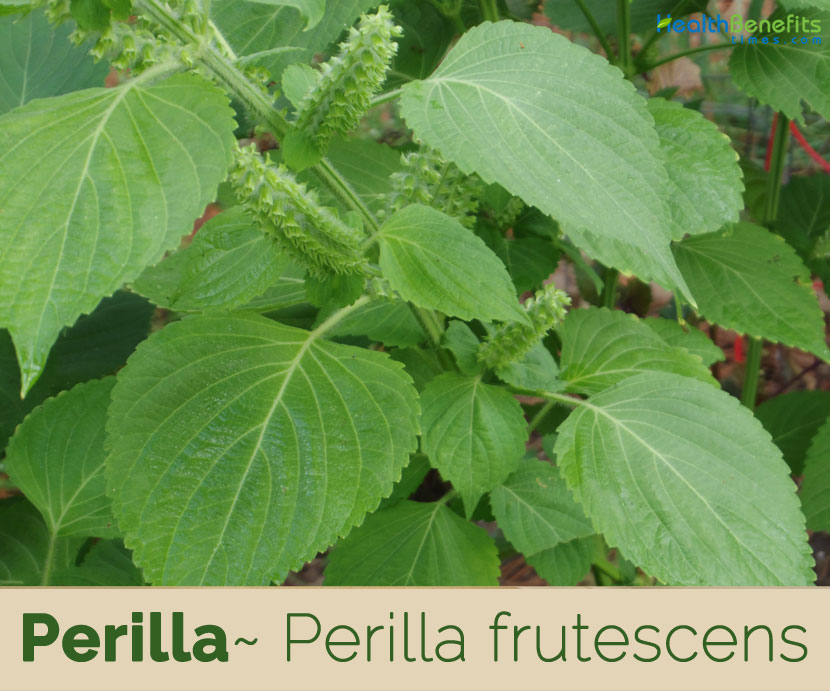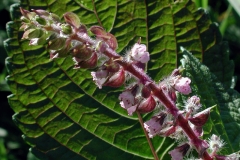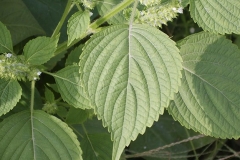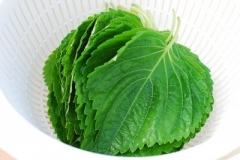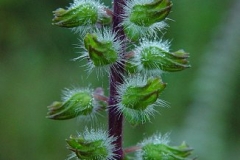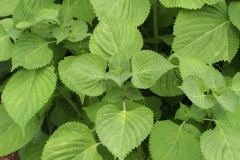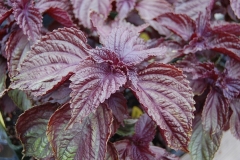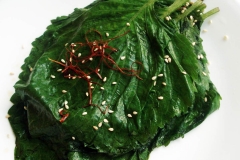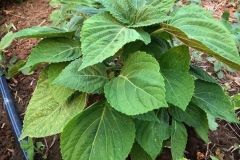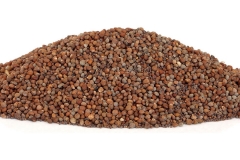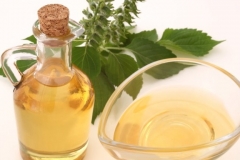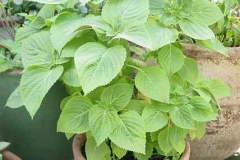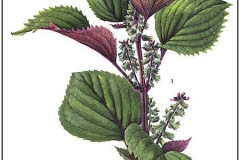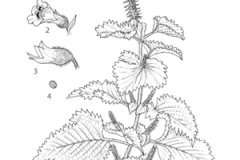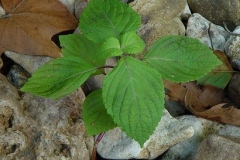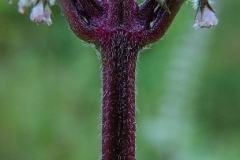There are both green-leafed and purple-leafed varieties. It is typically related with Japanese cuisine, where it is usually called shiso. Perilla oil is used in Asia for medicinal purposes and as a food flavoring in candies and sauces. Perilla is a rich source of omega-3 fatty acids and the leaves are used as a condiment for tofu and as a garnish for tempura. The leaf of this plant is a common garnish in many Asian cuisines, often seen in soups, salads, and sushi dishes. It is a very attractive plant for the garden and attracts butterflies. It is an aromatic plant with a strong minty smell. Various perilla varieties are traditionally used by local people, the leaves are used as a vegetable and the seeds supply nutritious cooking oil. In the United States, perilla is a weed pest, toxic to cattle after ingestion. Deep red leaves of some perilla varieties purportedly resemble the color of uncooked beef, hence the common name.
Plant Description
Perilla is an erect, annual freely branching, herbal medicinal, aromatic, functional ornamental perennial plant that grows about 60–90 centimeters (24–35 in) tall. The plant is found growing in dry rocky woodlands, edges of springs, sand and gravel bars along rivers, disturbed weedy meadows, gravelly areas along railroads, edges of yards, areas near gardens, back alleys in cities, and various waste areas, pastures and fields, dry woods and in waste places. The plant grows readily in different kinds of soil, including those containing loam, sand, and gravel. Stem is square with obtuse angles, 0.5-1.5 cm in diameter, often profusely branched, finely pilose to densely villous and glandular dotted. Dried stalks can persist through winter.
Leaves
Leaves are simple, decussately opposite, 7–12 centimeters (2.8–4.7 in) long and 5–8 centimeters (2.0–3.1 in) wide, gradually decreasing in size from bottom to top of the plant, finely pilose to densely villous. Petiole is 0-7 cm long, absent or very small in uppermost leaves. Blade is broadly ovate to circular, 2-13 cm × 1.5-10 cm, base rounded to cuneate, margin finely to coarsely serrate, sometimes wavy, apex short acuminate to mucronate. The leaves are green with occasional touches of purple on the underside.
Flower
Flowers are held in pairs along the stalk. The inflorescence is a villose corymb that may grow either terminally or from the leaf axils. Flowers bloom on racemes at the end of branches and the main stalk in late summer. The calyx, 3–4 millimeters (0.12–0.16 in) long, consist of upper three sepals and the hairy lower two. The corolla is 4–5 millimeters (0.16–0.20 in) long with its lower lip longer than the upper. Two of the four stamens are long. Flowers are small, bell-shaped, and a white or purple color with a distinctive ring of fine hairs along the bottom in terminal spikes or emerging from leaf axils and four stamens are present in most species in that family. Flowering normally takes place from
Fruits
Fertile flowers are followed by 4 sub globose nut-lets 1-2 mm in diameter, grey-brown to black-brown, with netted surface, enclosed within the persistent calyx. It split open to reveal seeds when ripe. Seeds are soft or hard, being white, grey, brown, and dark brown in color and globular in shape. 1000 seeds weigh about 4 grams (0.14 oz.). Perilla seeds contain about 38-45% lipid.
Health benefits of Perilla
Listed below are few of the health benefits of using Perilla
1. Lowers Cholesterol
Seeds are great for lowering LDL or bad cholesterol and increasing HDL or good cholesterol thus helping to prevent cardiovascular disease, heart attacks, and strokes, and even cancer. And it also helps to prevent atherosclerosis.
2. Lowered Heart Disease Risk
Just like what’s mentioned earlier, the superb ratio of healthy fats in perilla makes this herb beneficial for preventing heart disease. It helps in maintaining healthy blood vessels, keeping them from becoming hard and prone to accumulating plaque. Antioxidants in perilla help prevent the oxidation of cholesterol in the food you eat, keeping them out of the arteries where they can collect and cause some very serious problems.
3. Anti-Depressant Agent and Great for the Brain
Because of all the powerful antioxidant properties of Perilla Seeds, the oils have a major effect on our dopamine centers in our brain thus helping to make us feel happier. And it also helps to optimize brain function and help with memory. The University of Maryland Medical also found that ALA found in Perilla Seeds can help with depression.
4. Increase Immunity
Compounds present in this herb have been recognized to trigger interferon activity which helps in promoting the health of the immune system and thus keeping numerous diseases at a bay.
5. Reduce stomach discomfort
Leaves of perilla consist of flavonoids, which help relieve the signs of stomach discomfort. This includes bloating, nausea and the passage of gas. The oil can also help reduce inflammation in the stomach thus improving digestion whilst reducing the effects of indigestion.
6. Reduced Oxidative Stress
There are a number of health nightmares that can be traced back to oxidative stress. They range anywhere from arthritis to cancer. Oxidative stress is something that happens when the body becomes flooded with excessive amounts of free radicals. Antioxidants found copiously in perilla are the ones that are totally capable of wiping out those excess free radicals, and that’s why the herb is often used for the prevention of issues related to oxidative stress.
7. Cancer
Because of all the powerful antioxidants Perilla Seeds have the ability to prevent the growth of cancer cells as found in laboratory settings. The more antioxidants we consume daily the lower our chances of having cancer.
8. Prevents Cavities
Perilla Seeds and the plant consist of lots of Luteolin which helps to reduce dental cavities. Japan’s Asahi University found that Perilla Seeds and leaves prevent the growth of detrimental bacteria in the mouth.
9. Effective shield against sun
Paste of the perilla leaves when applied on skin tends to prevent sun burn. Consumed as a decoction it is also known to be beneficial in preventing sun stroke. Not only does it prevent the above mentioned diseases it also helps in curing sunstrokes or warts if already occurred.
10. Decrease stomach and intestinal discomforts
Leaf is especially important for this function, as it consists of flavonoids, rosmarinic acid, and caffeic acid. Research has shown that perilla can help improve bloating, passage of gas, rumbling, and feeling of fullness shortly after starting to take an extract through prokinetic (helps strengthen the lower esophageal sphincter, thus preventing acid reflux) and antispasmodic (prevents and decreases cramping) effects.
11. Managed Joint Pain and Inflammation
Fatty acids present in perilla are helpful most especially for people who are regularly bugged by achy and swollen joints. It’s for the fact that those beneficial fats support the joints, keeping them from becoming painful and inflamed. Supplementing with perilla may help those who are susceptible to arthritis as they can be saved from the need to regularly pop NSAIDs in their mouths, which are drugs known to carry all sorts of side effects and risks.
12. Great for Asthma, Colds, Allergies, and Bronchitis
Perilla seeds consist of lots of quercetin, luteolin, alpha-lineolic acid, and rosmarinic acid which are all great for healing the respiratory tract and helping a person to breathe easy. “International Archives of Allergy and Immunology” article found that with four weeks of treatment with Perilla Seeds greatly increased lung capacity.
13. Effective against infection or swelling
The herb has been known to contain rosmaric acid which is one of the prime compounds which helps in prevention against skin allergies and swelling. Extract from the leaves is known to prevent any such situations from occurring.
14. Great for Problem Skin
Perilla Oil is used in cosmetics and works great for problem skin. With all the anti-inflammatory qualities, antioxidants, antibacterial, and the ability to help retain more water in the skin it works wonders for healing rashes, acne, and helps to get rid of wrinkles and create a youthful great looking skin.
15. Maintain Oral Health
According to the researches carried out in Japan this herb is known to possess anti-microbial properties and tends to maintain oral health. When consumed orally it tends to avoid issues such as bleeding of gums as well as reduction of any oral cavities.
16. Improves wellbeing
Perilla consists of Rosmarinic and Caffeic Acid, which have been recognized as having antidepressant qualities, therefore helping relieve you of stress and anxiety issues. The herb is also used in aromatherapy to help people relax and let go of any tension they tend to harbor and feel.
17. Managed Joint Pain and Inflammation
Fatty acids present in perilla are helpful most especially for people who are regularly bugged by achy and swollen joints. It’s for the fact that those beneficial fats support the joints, keeping them from becoming painful and inflamed. Supplementing with perilla may help those who are prone to arthritis as they can be saved from the need to regularly pop NSAIDs in their mouths, which are drugs known to carry all sorts of side effects and risks.
18. Reduced Allergy Signs and Symptoms
Perilla is known to lend a hand to people who are suffering from allergies. That’s because the herb is proven to help control the release of histamine in the body, which happens during exposure to allergens. Numerous researches have shown that perilla is indeed effective in controlling various allergy signs and symptoms, including itchy and watery eyes, runny nose, sneezing and even shortness of breath.
Traditional uses and benefits of Perilla
- Dried leaves are used for many applications in Chinese herbal medicine, including treatment of respiratory conditions (e.g. asthma, coughs, colds), as an antispasmodic, to induce sweating, to quell nausea, and to alleviate sunstroke.
- It decreases inflammation or swelling in the Body.
- Seed extract of Perilla is used to treat Allergies.
- Methanolic extract of roasted defatted Perilla seed exhibits strong Antioxidant property.
- It prevents the cells from any oxidative damage.
- Perilla Seed extract prevents cavity and periodontal diseases.
- It prevents the growth of any harmful microorganisms in the Body.
- Perilla leaf extracts acts as an immuno stimulant.
- It activates Phagocytosis in the Body.
- It stimulates the working of Immune System.
- Perilla Seed Oil possesses neuro-protective effect.
- It protects the nerve cells from any functional impairment or damage.
- Oral ingestion of Perilla Seed oil makes brain cells less sensitive to reactive oxygen, Nitrogen and Mitochondrial Dysfunction.
- Perilla Oil also lowers bad Cholesterol level in the Body.
- Perilla leaf is considered as a surface-relieving herb used for common cold and similar types of acute disorders that might involve stuffy nose, cough, and headache; it is considered best for treating “wind-cold” type disorders.
- Seeds of this herb are also chewed and consumed for sound oral health.
- In traditional Chinese medicine, shiso or perilla leaves infusions were used to treat persistent cough and stuffy nose symptoms.
- Shiso tea or powder was believed to alleviate nausea and vomiting in pregnancy as well as relieve abdominal cramps as a result of indigestion or food poisoning.
- Immature flower clusters are used as a garnish for soups and chilled tofu.
- Older flower clusters are fried and eaten.
- Seeds are preserved in salt or are used as a spice in pickles, tempura and miso.
- Leaves are used in the treatment of colds, chest stuffiness, vomiting, abdominal pain etc.
- The juice of the leaves is applied to cuts and wounds.
- Seed is used internally in the treatment of asthma, colds and chills, nausea, abdominal pain, food poisoning and allergic reactions (especially from seafood), bronchitis and constipation.
- Stems are a traditional Chinese remedy for morning sickness.
- Leaf juice is used to expel intestinal worms and cut wounds in Dekhatbhuli, Nepal.
- Perilla root paste mixed with goat urine is used as a poultice for rheumatoid arthritis twice daily for one week.
- Juice of the fresh leaves is utilized for curing injuries and the seed oil for massaging infants.
- Other indications for using the leaves include dissipating colds, promoting the circulation of Qi, toning the stomach, and detoxification.
Culinary Uses
- Leaves and seeds are widely eaten in Asia.
- Perilla buns are made with glutinous sorghum or glutinous rice flour dough filled with red bean paste and wrapped with perilla leaves.
- Perilla leaves are used to make efen, “steamed bun” in Manchu cuisine.
- Perilla seeds are roasted and ground with salt, chilies, and tomatoes to make a savory side dish or chutney.
- Seeds of Bhangira (cultivated Perilla) are eaten raw, the seed oil is used for cooking purposes, and the oil cake is consumed raw or fed to cattle in Kumaon.
- Roasted seeds are also ground to prepare spicy chutney.
- Seeds and leaves of Perilla are also used for flavoring curries.
- Manipuri cuisine uses the ground roasted seed in a salad locally known as ‘singju’.
- In Korean cuisine, perilla leaves are widely used as an herb and a vegetable.
- It can be used fresh as Assam vegetable, fresh or blanched as a namul vegetable, or pickled in soy sauce or soybean paste to make jangajji (pickle) or kimchi.
- Perilla seeds are either toasted or grounded into powder called deulkkae-garu or toasted and pressed to make perilla oil.
- Toasted deulkkae powder is used as a spice and a condiment for guk (soup), namul (seasoned vegetable dishes), guksu (noodle dishes), kimchi, and eomuk (fishcake).
- It is also used as coating or topping for desserts: Yeot and several tteok (rice cake) varieties can be coated with toasted perilla powder.
- Perilla oil made from toasted perilla seeds is used as cooking oil and as a condiment.
- In Korean-style western food, perilla leaves are occasionally used to substitute basil and the seed powder and oil is used in salad dressings as well as in dipping sauces.
- Seeds are good in salads, and they are great in soups, stews, veggie dishes, and other dishes.
- Plant yields an essential oil which is used as a food flavoring in candies and sauce.
- Seed is used for meat preservation and flavoring foods.
Recipes
Japanese-style Ume Shiso Spaghetti
Ingredients
- 10 umeboshi
- 1⁄4 cup sugar
- 2 tablespoons mirin
- 10 green shiso, washed
- 300 g dried spaghetti (thin)
- 30 g butter
- Salt
Directions
- First soak umeboshi in water for 3-4 hours to remove some of the saltiness. It is best to change water every hour.
- Remove umeboshi pits by using a small knife. Mince very, very finely until paste or use a food processor and pulse until it is a smooth paste.
- Using a small pan, combine ume paste, sugar, and mirin over low heat. Turn down to simmer and stir frequently. It is done when the paste becomes shiny. This usually takes about 10-13 minutes. It will take on a beautiful shiny appearance and color.
- Remove from heat.
- Gather shiso leaves and roll into pencil shape. Slice thinly into chiffonade.
- Place butter in a large bowl and beat until creamy. Combine 3 T ume paste and mix well.
- Boil spaghetti until al dente and drain. Mix spaghetti with butter/ume mixture along with thinly sliced shiso in the bowl.
- Serve either hot or at room temperature.
Other facts
- In Japan, perilla leaves are used as a garnish on raw fish dishes serving the dual purposes of flavoring and as an antidote to possible food poisoning.
- 1000 seeds weigh about 4 grams (0.14 oz.).
- Seeds oil is used in making paints, varnishes, water proofing etc.
- Essential oil is used as a food flavoring and in dental products.
- Stems and leaves have a very strong characteristic odor which superficially resembles basil and coleus.
- Perilla also gains market importance in cosmetics, being processed in skin creams, soaps, and dermatological medicinal preparations, because of its biological activities.
- As an antidote, perilla leaf has been used in fish and crab dishes in China and Japan for a long time.
Precautions
- Animals grazing on perilla have developed fatal pulmonary edema and respiratory distress.
- Perilla Oil may cause Dermatitis.
- This herb should be avoided by pregnant women.
References:
http://www.theplantlist.org/tpl1.1/record/kew-150299
https://www.itis.gov/servlet/SingleRpt/SingleRpt?search_topic=TSN&search_value=32634#null
https://davesgarden.com/guides/pf/go/197204/
https://npgsweb.ars-grin.gov/gringlobal/taxonomydetail.aspx?id=27364
http://www.missouribotanicalgarden.org/PlantFinder/PlantFinderDetails.aspx?kempercode=b761
https://www.drugs.com/npp/perilla.html
https://plants.usda.gov/core/profile?symbol=pefr4
https://en.wikipedia.org/wiki/Perilla_frutescens
https://www.invasiveplantatlas.org/subject.html?sub=3413
https://www.discoverlife.org/20/q?search%3DPerilla%2Bfrutescens
https://uses.plantnet-project.org/en/Perilla_frutescens_(PROSEA)
Comments
| Perilla Quick Facts | |
|---|---|
| Name: | Perilla |
| Scientific Name: | Perilla frutescens |
| Origin | Southeast Asia and Indian highlands, and is traditionally grown in the Korean peninsula, Southern China, Japan and India |
| Colors | Grey-brown to black-brown |
| Shapes | Sub globose nut-lets 1-2 mm in diameter, grey-brown to black-brown, with netted surface, enclosed within the persistent calyx |
| Taste | Sweet, Pungent, Acrid |
| Health benefits | Lowers Cholesterol, Cancer, Lowers Heart Disease Risk, Reduced Allergy Signs and Symptoms,Maintain Oral Health, Great for Asthma, Colds, Great for Problem Skin, Allergies, and Bronchitis, Decrease stomach and intestinal discomforts, Increase Immunity, Prevents Cavities, Anti-Depressant and Great for the Brain, Reduce stomach discomfort, Reduced Oxidative Stress, Managed Joint Pain and Inflammation, Improves wellbeing, Effective against infection or swelling,Effective shield against sun |
| Name | Perilla |
|---|---|
| Scientific Name | Perilla frutescens |
| Native | Southeast Asia and Indian highlands, and is traditionally grown in the Korean peninsula, Southern China, Japan and India as a crop |
| Common Names | Beefsteak plant, Chinese basil, Common perilla, Green-leaved perilla, Perilla, Rattlesnake weed, Wild coleus, Wild perilla, Wild sesame, beefsteak mint, purple mint, Shrubby perilla, Shiso, Ji Soo, Perilla, Purple Shiso, purple perilla, blueweed, Joseph’s coat, wild coleus, Wild Basil, Wild Red Basil ‘Bicolor Shiso’ |
| Name in Other Languages | Arabic: Biarila lasinmia (بيريلا لاسنمية) , birila shajiria (بيريلا شجيرية ) Assamese: Arim, Bana-tila (বন-তিল) Ban-til, Bana-tulsi (বন-তুলসী) Bengali: Ban tulsi Chinese: Bai su (白苏), Rěnhúmá (荏胡麻), Chì zǐsū (赤紫蘇), Qīng zǐsū (青紫蘇), Sū yè(蘇葉), Qing su, Zi su, Zi Su Ye, Zi Su zi Danish: Bladmynte, Kinesisk Mynte, Perillafrø, Perillablad Dutch: Japanse munt English: Beefsteak plant, Chinese basil, Common perilla, Green-leaved perilla, Perilla, Rattlesnake weed, Wild coleus, Wild perilla, Wild sesame, beefsteak mint, purple mint, Shrubby perilla Estonian: Pronks-lutiklill, Pronksleht Finnish: Veripeippi French: Pérille, Pérille verte sauvage, Pérille verte de Chine, Persil japonais, Mélisse verte sauvage, Pérille faux-basilic, Sésame sauvage German: Chinesische Melisse, Nessellippe, Schwarznessel, Wilder Sesam, Shiso, perilla Hebrew: Perilah (פְּרִילָה) Hindi: Bhangiri, Bhangjeera, anjira, Bhanjira(बनजीरा), Pērillā (पेरिल्ला), phrooteesens (फ्रूटीसेन्स) Hungarian : Kínai bazsalikom, Vad szezám Italian: Perilla Japanese: Ao jiso (アオジソ), Shiso (シソ), Shiso (紫蘇), Shiso (し そ), Egoma, Soyō; Aka-shiso, Akajiso, Ao-shiso, Aojiso Korean: Deul kkae (들깨), Deul kkae yeop (들깨엽), Deul kkae ip (들깨잎), Kkaes ip (깻잎), soyeob (소엽), kkaes-ip (깻잎), Deulggae, Tulkkae, Soyeob, Soyop, Kkaennip, Ggaesip Laotian: Nga: ch:in, Nga: chieng Malay: Daun shiso Manipuri: Thoiding (ꯊꯣꯢꯗꯤꯡ) Mizo: Chhawhchhi Nepali: Silaam (सिलाम) Norwegian: Perilla, Perillafrø, Perillablad Persian: پریلا فروتسانس Portuguese: Perila, Manjericão-japonês, Shissô Russian: Yaponskii bazilik (Японский базилик), Perilla Iaponsko (Перилла Японско), Perilla bazilikovaia (Перилла базиликовая), Perilla kustarnikovaia (Перилла кустарниковая) Spanish: Perilla Swedish: Bladmynta, Kinesisk bladmynta Tangkhul: Hanshi Thai: Nga khi mon (งาขี้ม้อน), Nga mon (งามน), Ngae (แง), No Turkish: Çin fesleğeni Uttarakhand: Bhangira (भंगीरा) Vietnamese: Lá tía tô, Rau tía tô, Tía tô |
| Plant Growth Habit | Erect, annual freely branching, herbal medicinal, aromatic, functional ornamental perennial plant |
| Growing Climates | Dry rocky woodlands, edges of springs, sand and gravel bars along rivers, disturbed weedy meadows, gravelly areas along railroads, edges of yards, areas near gardens, back alleys in cities, and various waste areas, pastures and fields, dry woods and in waste places |
| Soil | Grows readily in different kinds of soil, including those containing loam, sand, and gravel |
| Plant Size | 60–90 centimeters (24–35 in) tall |
| Stem | Square with obtuse angles, 0.5-1.5 cm in diameter, often profusely branched, finely pilose to densely villous and glandular dotted |
| Leaf | Simple, decussately opposite, 7–12 centimeters (2.8–4.7 in) long and 5–8 centimeters (2.0–3.1 in) wide, gradually decreasing in size from bottom to top of the plant, finely pilose to densely villous; petiole 0-7 cm long, absent or very small in uppermost leaves |
| Flower | Flowers are small, bell-shaped, and a white or purple color with a distinctive ring of fine hairs along the bottom in terminal spikes or emerging from leaf axils, and four stamens are present in most species in that family |
| Fruit Shape & Size | Composed of 4 sub globose nut-lets 1-2 mm in diameter, grey-brown to black-brown, with netted surface, enclosed within the persistent calyx |
| Fruit Color | Grey-brown to black-brown |
| Seed | Seeds can be soft or hard, being white, grey, brown, and dark brown in color and globular in shape |
| Propagation | By seed |
| Flavor/aroma | Distinctive musky, mint-like odor |
| Taste | Sweet, Pungent, Acrid |
| Plant Parts Used | Leaves, Stems, Seeds |
| Season | End of September and the beginning of October and this varies according to the intended use of the crop and climate condition in the area |
| Health Benefits |
|


